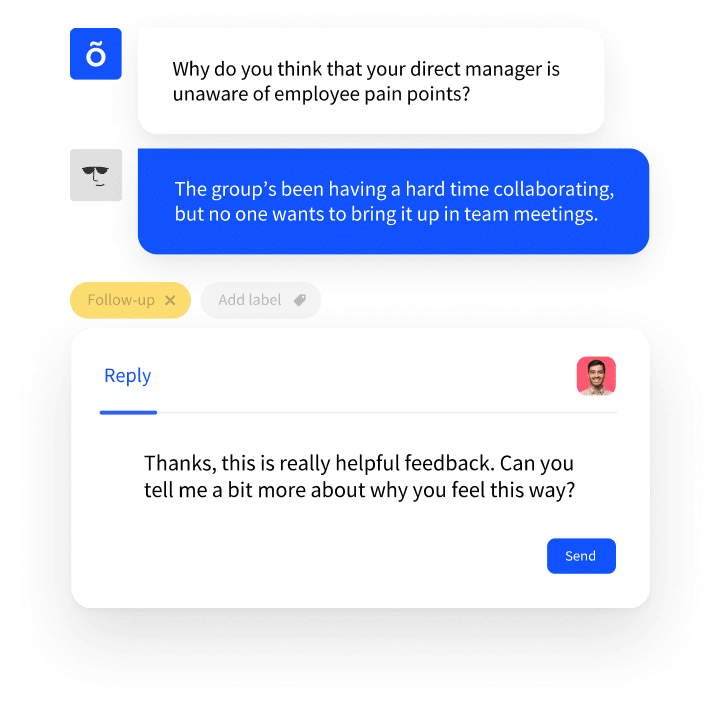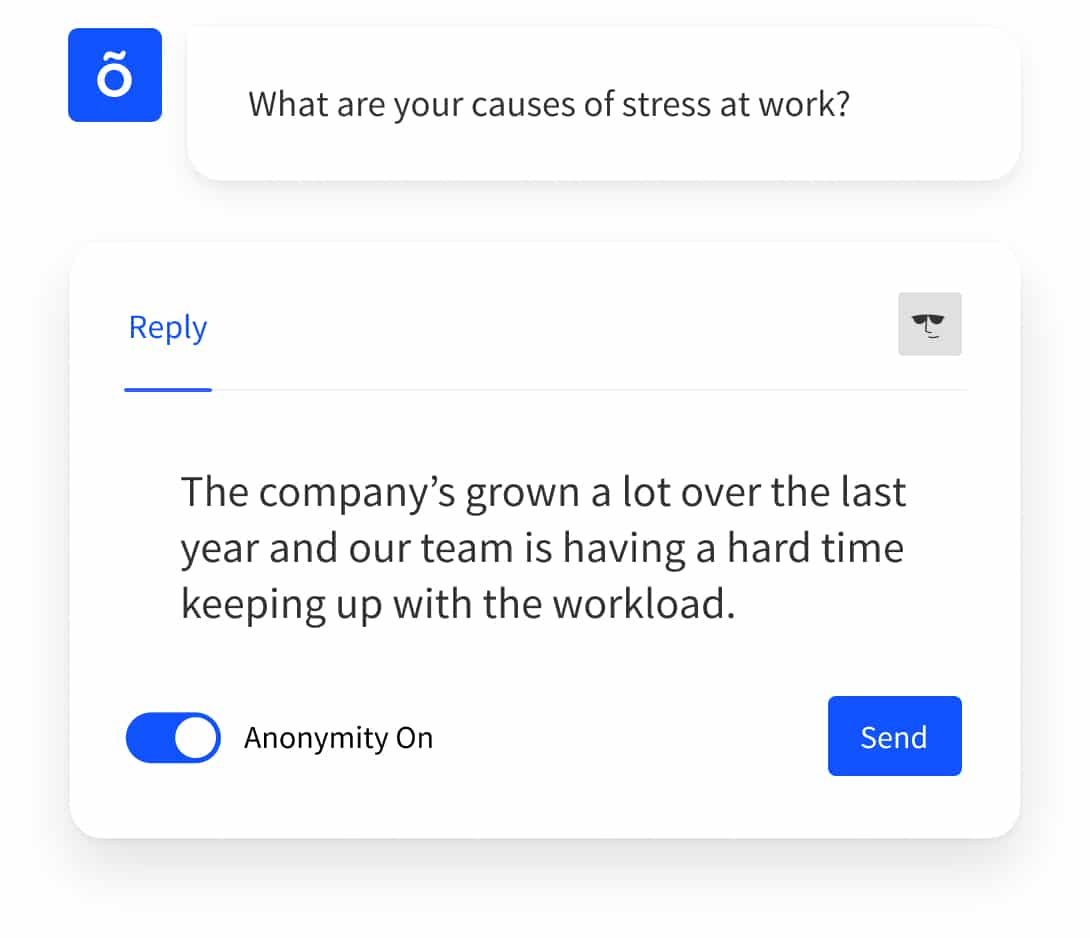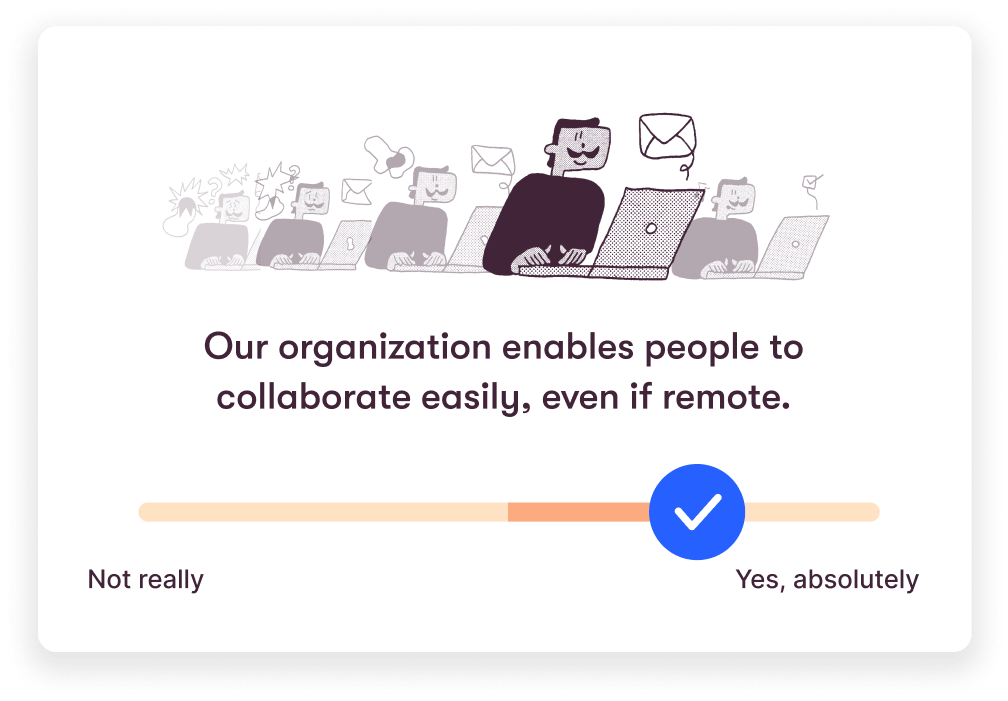Feedback is a gift. At least, that’s what many employees say, but is that how they really feel?
Some employees may not feel comfortable being explicitly transparent with their feedback for fear of retaliation or being labeled challenging to work with.
This is where anonymous employee feedback comes in.
Not only does anonymity increase transparency, it also highlights workplace challenges and initiates more effective two-way conversations. With anonymous feedback, managers can understand more clearly what they need to do to better support their teams.
Let’s take a closer look at the best methods and tools that facilitate anonymous feedback and how they can foster trust and engagement in the workplace.
Assess your organization’s employee experience in minutes

What's in this article
Benefits of anonymous employee feedback
Employee feedback is essential to the functioning of the modern workplace. While some employees may be more at ease expressing themselves directly to their managers or peers, others may feel less inclined to share their thoughts if their names are attached.
Anonymous feedback allows people to share new ideas or convey anxieties in a judgment-free zone and builds trust between team members.
Positive effects of anonymous feedback:
- Anonymous feedback encourages employees to bring up tough topics in a safe environment.
- Asking for feedback lets your team know that you care about their happiness.
- Managers can discover issues they didn’t know about, and act to resolve them before they lead to conflict, failure, or turnover.
1. Creates a safe space for honest feedback
Healthy teams have psychological safety at their core; they champion employee well-being and cultivate an environment of trust and confidence that allow team members to succeed.
Employees may feel more inclined to share their concerns openly when offered the opportunity to collect anonymous feedback. This method allows managers to zero in on some of the issues that may have otherwise gone unnoticed and nudges them in the right direction on how to fix them.
Employees welcome the safety of anonymity because it gives them a chance Employees welcome the safety of anonymity because it gives them a chance to share meaningful information. It gives them agency to express feelings they’d always had but didn’t know how to communicate. The result is greater cohesion within businesses, reduced employee turnover, and better teamwork.

Anonymous feedback encourages trust and connection
2. A feedback process builds trust and authentic connections
Employees want to feel supported by their team and their managers. Encouraging your team to share their thoughts (whether anonymously or not) shows that you value resolving their trepidations and genuinely care for their well-being.
Employees may choose to submit feedback anonymously, but as confidence grows and they see how managers react to feedback, employees may begin to disclose their identity, ultimately building employee-manager trust
3. Collect employee feedback with confidence
Anonymity allows for openness in response and will enable managers to feel confident when asking tough questions.
There are some types of questions that your team members might feel more comfortable answering anonymously, like:
- Does your team have the resources they need to get their work done on time?
- Are there team dynamics that need to be addressed?
- Is a change required for a healthier dynamic?
- Would this result in productivity and employee engagement?
3 digital methods for collecting anonymous employee feedback
We’ve gone over the benefits of anonymous feedback, but let’s dive into how you can go about actually collecting this data.
While traditional methods like a suggestion box in the office may have worked well once upon a time, it no longer serves the increasingly remote modern-day workforce.
Here are some of the best digital methods for collecting employee feedback:
Feedback software
Feedback apps and software have been gaining popularity thanks to their ease of use and accessibility, especially with hybrid workforces.
Most tools can be set up with automatic functions that allow you to schedule surveys, questionnaires, polls, or virtual comment boxes, removing most manual legwork from your plate. These platforms will gather your results and generate practical analytics that allows you to store data and track trends over time.
Employee surveys
Anonymous digital surveys allow you to tailor questions for your employees. Managers can ask as many or as few questions as they like and in their preferred format (i.e., yes or no questions, polls, short-answer questions).
Although helpful for gauging the general sentiment around company culture and collecting feedback, managers may still need to sift through responses and catalog anonymous comments themselves. And unlike many feedback software, the main drawback for most free employee survey platforms is that they aren’t equipped to analyze your collected feedback and provide you with reports to monitor employee happiness and other metrics.
Anonymous email inbox
While you can’t mask your identity through regular email providers, setting up an anonymous inbox allows employees to submit their comments and concerns and preserve their anonymity. A drawback to this method, though, is the manual effort it requires to set up and organize the inbox and collect and analyze comments.

Employees can enable or disable anonymity when sharing feedback.
Best anonymous feedback tools
Several anonymous feedback tools exist on the market today, equipped with different functions and features to serve various needs.
Officevibe - Anonymous feedback and Pulse Survey software
While there are many tools out there that have been designed to collect anonymous feedback in the workplace, Officevibe’s easy-to-use platform is one of the most intuitive and accessible ways for employees to be upfront about their concerns in a non-intimidating setting.
Officevibe’s Pulse Survey tool enables you to collect employee feedback without disrupting the workday flow and allows you to start working on strategies to improve engagement.
Employees can discuss areas of concern, highlight what they enjoy about their jobs, and even celebrate a stand-out coworker with the new Good Vibes feature.

Survey Monkey
Survey Monkey is one of the more popular players in the digital feedback game. The platform offers users pre-set templates for topics ranging from customer service to employee satisfaction and includes different subscription levels to meet individual needs.
Free Suggestion Box
Free Suggestion Box is a free website where managers can create a link to a conversation topic and send it out to employees to drop comments or share ideas. It’s a simple way to solicit feedback, but unlike Officevibe or other more intricate platforms, this anonymous feedback box doesn’t allow managers to observe changes over time.
Poll Everywhere
Poll Everywhere is another tool that offers users some fun options for submitting feedback, including quizzes and word clouds. The live polling function allows teams to communicate ideas in real-time, but some users have noted that the tool caps the number of participants, making it more challenging to get a clear picture of how employees feel.
Peachy Mondays
Another tool on the market used to collect feedback is the UK-based platform, Peachy Mondays. While the solution offers an array of questions to gather critical feedback using up-to-date research, Peachy Mondays require a minimum of 500 users per company, making it less accessible for a smaller organization.
How to get anonymous employee feedback using Officevibe
Officevibe’s anonymous feedback tool allows employees to share feedback with their manager at any given time easily. It gives your team a simple and safe vehicle to express their voice on the many matters of their day-to-day work.
Collect anonymous feedback with surveys
With Pulse Surveys, employees answer a handful of relevant questions once a week, like “My organization’s values are aligned with values I consider important in life,” or “Is the feedback you get specific?” Thanks to an intuitive algorithm, Pulse Surveys shuffle questions so that employees aren’t asked the same thing too frequently, avoiding survey fatigue.
Officevibe’s anonymous feedback tool also offers the option for feedback to be turned on or off so that the focus remains on what was said rather than who said it. This anonymous reporting ensures that employees can offer their candid feedback without fear of repercussion.
Respond to direct employee feedback
You can even directly respond to anonymous employee feedback in Officevibe! Turn employee feedback messages into a chat to dive into the nitty-gritty of a topic while employees stay anonymous. Employees can enable or disable anonymity when sharing feedback, depending on their comfort level.
The beauty of the anonymity feature is that it helps employees spark conversations that might otherwise be difficult to broach, like discussions related to their work environment, compensation, relationships with managers and other colleagues, etc. Ultimately, it fosters a company culture of inclusion and consistent communication, essential ingredients to a successful team.
One manager shares her experience using Officevibe:
It shows me things that would be invisible otherwise. I wanted an option where my team could leave anonymous feedback. I was new, and I knew they were not going to give it to me directly because they didn’t trust me yet.
Katelyn Koplan, Operations Manager at Back Office Betties
How to implement an anonymous employee feedback process
Once you’ve collected data from your employee feedback surveys, it’s time to put your money where your mouth is and address the issues or continue delivering on some of the things your team enjoys.
Analyze employee feedback
After your team has submitted their thoughts using the feedback tool, take a moment to review it. Take note of behavioral patterns. Notice low productivity, stress-strained relationships, or low collaboration.
Survey results are broken down into 10 key engagement metrics, including happiness, personal growth, job satisfaction, and relationship with the manager, to help you target areas that may need improvement. As you collect feedback, it will be helpful to refer back to situations and identify recurring pain points on your team.
Communicate feedback with your team
Spend time crafting the best way to present your findings to your team. According to our data, 82% of employees using Officevibe believe their direct manager cares about their opinion, so it’s important to never let feedback go unanswered.
Thanks to the easy-to-read reports, you can apply what you’ve learned and start making data-driven decisions on strengthening relationships, shifting employee engagement, and build strong productivity.
One of the most effective ways to enhance employee engagement is implementing a feedback loop where you can engage in genuine two-way discussions with your team.
Here are some other employee feedback examples you can use to get started today!
Collaboration has improved more than anything. Officevibe gives us the chance as a team to look at scores together in-depth and collaborate on the results – especially if we’re using Custom Polls to survey the actions we’re taking.
Matt Collins, Managing Director at Platypus Digital
When you allow employees to share their thoughts and nurture their concerns, you create an environment of trust, confidence, and mutual respect. Officevibe’s anonymous employee feedback tool helps managers do this with ease and efficiency.
Anonymous employee feedback FAQ
How do I get anonymous employee feedback?
One of the best ways to gather anonymous employee feedback is through specially-developed tools and platforms like Officevibe.
Officevibe’s Pulse Surveys allow you to ask your team-specific questions weekly and help managers zero in on areas of improvement.
Is anonymous feedback really anonymous?
Most employee feedback software claim to offer users complete anonymity, but Officevibe users can rest assured that their answers will not be displayed; only aggregated results are presented.
Should employee surveys be anonymous?
Every organization operates on its own wavelength, so different methods will work for different groups. By offering people the opportunity to fill out a survey anonymously, you foster an environment of honest communication that values employee outlook.
Is anonymous feedback effective?
Anonymous feedback allows employees to share ideas in a safe space without fear of repercussions. This open feedback process encourages people to start discussions on important subjects they may not feel comfortable broaching in a public forum.
How do you deal with negative feedback anonymously?
While employees must feel able to voice their opinions freely, it’s important to remember that mutual respect is a key pillar of a solid and productive team. Managers should consider all comments to improve employee satisfaction.
Equip HR and managers with tools to engage, recognize, and drive performance.




